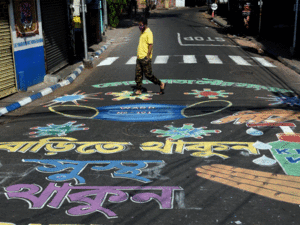View: Alarmist numbers based on dodgy assumptions shouldn’t be used to prolong lockdown in its present form

As of April 7, the health ministry numbers are of 4,312 active cases, 352 cured/discharged, and 124 deaths.

COVID-19 CASES
WorldIndiaConfirmed5,274Deaths149Confirmed1,426,096Deaths81,865By Bibek Debroy & Vijay P Ojha
On March 24, a 21-day lockdown was announced to control the spread of Covid-19. Despite the odd breach, overall compliance has been good, and there has been citizen support. Specifically, the objective was to limit India to Stage 2 (local transmission) and prevent a slide into Stage 3 (community transmission).
There were some alarmist predictions, suggesting cumulative infection numbers of 900 million by June. If 900 million people are infected and a high case fatality rate of 2% is assumed, 18 million Indians may die. Models make assumptions, and assumptions are not proven propositions.
For instance, the total number of infected form three distinct categories: (1) infected, but asymptomatic; (2) infected and symptomatic, but unreported; (3) infected and identified as infected. In modelling, should one club all three together? Can one mechanically apply a fatality rate deduced from Category 3 on 900 million? Can one facilely apply a fatality rate from other countries, without controlling for age, life expectancy, other morbidity conditions, or even temperature? Which countries does one choose?
Take China. It has, on April 7, 81,740 identified infections — though questions have been asked about definitions used in Chinese numbers, such as non-inclusion of asymptomatic cases. Even if one assumes India’s numbers could be three times as much, there will be 246,000 identified infections. With a fatality rate of 5% for identified infections, the absolute figure is 12,300, a far cry from 18 million.
Alarmist numbers based on questionable assumptions should not be used to prolong the lockdown, at least not in its present form. Even if there are 25,000 deaths, the economic costs of the present lockdown are disproportionately high. India is probably under-counting infections. But under-counting of deaths is unlikely. In any event, a fatality rate is a ratio. Under-counting the denominator makes the case for low Indian fatality higher.
What has lockdown in its present form achieved? Comparison of India’s epidemic growth curve with other countries depends on the timeline and country concerned. For instance, our growth curve is flatter than the US’s, Spain’s or Italy’s, but steeper than Japan’s and Singapore’s. What has the lockdown done to the underlying shape of the curve?
The answer is a counter-factual. In its absence, the number of infections and deaths may have been twice as high. For all one knows, it may have simply shifted the curve to the right. With large numbers, most variables have bell-shaped symmetric distributions. The present slow rate of increase may imply (a) the curve has shifted to the right; (b) the curve has been flattened. In either event, we have to reckon the curve with a long tail to the right.
If one plots number of cases over time, for (b), the curve is no longer that high, but becomes longer. As result of the epidemic, the same number of people may get infected, but over a longer period of time. When not normal, variables sometimes have long normal distributions. Even then, one has to reckon with a long tail. The time bought allows for possible development of herd immunity. It allows for supply (including domestic manufacture) of testing kits, personal protection equipment (PPE), ventilator machines, creation of testing centres and isolation beds in district/sub-district hospitals and awareness campaigns.
Reducing R0 (the mathematical term that indicates the average number of people who will catch a disease from a contagious person) to less than 1 (a contagious person transmitting the disease to ‘less than one person’), when the disease ceases to be an epidemic, is a long haul. Development of vaccines will also be a long haul. Nor is there much point in complaining about the inadequacy of medical infrastructure. Solving that is long-term.
India is a large and heterogeneous country. As of April 7, the health ministry numbers are of 4,312 active cases, 352 cured/discharged, and 124 deaths. If one separates the Tablighi Jamaat event of New Delhi, evidence for community transmission is limited. The shape of the epidemic curve in Delhi or Mumbai is not the same as its shape in Bengaluru. Lockdown is not a binary.
A slide into the community transmission stage is almost inevitable, at least in some parts. But that does not warrant a continuation of the present 21-day lockdown in the middle of the rabi harvesting season, with the informal sector, daily wage workers and MSMEs bearing the brunt of the lockdown.
There was an initial identification of 75 high-risk districts. The targeted identification needs to be finer than that — zeroing in on hotspots at sub-district level, such as identified urban localities, including slums, where testing needs to be focused. India is not in a position to test the entire population, though pooled testing can make more efficient use of infrastructure. For example, in Delhi, Dilshad Garden and Nizamuddin are obvious areas where restrictions need to continue. Everywhere else, economic activity needs to be revived.
Easing of lockdown is also not a binary. In areas that aren’t hotspots, restrictions are needed on large gatherings. Obviously, as one moves away from a nationwide lockdown, and inter-state migration revives, unified procedures for such migration are needed. Targeted graduation from the lockdown and phased easing are the key.
But, while state governments need to identity hotspots, secluding them is easier said than done. There will also be testing and PPE constraints, even for those hotspots. However, that attempt to differentially break the chain of transmission is no argument for bearing disproportionately high economic costs.
Debroy is chairman, Economic Advisory Council to the Prime Minister. Ojha is director, Policy Modelling Association for Inclusive Development, New Delhi.
Source: indiatimes.com

